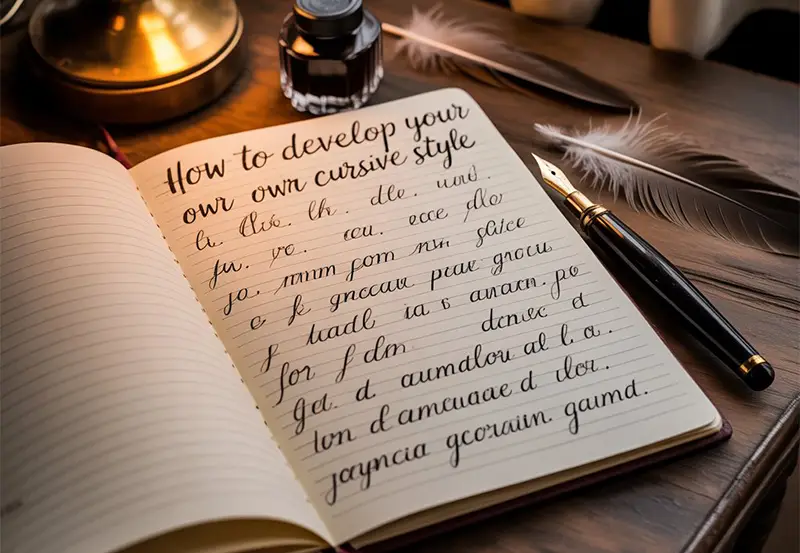Cursive writing has long been admired for its elegance, fluidity, and personal flair. Unlike print writing, cursive connects letters in a flowing motion, allowing for speed and aesthetic expression. In a digital world where typing dominates, developing your own cursive style can be a rewarding, almost meditative hobby—and a skill that adds charm to your personal notes, journal entries, invitations, or artwork.
This article will guide you through the process of creating a cursive handwriting style that is uniquely yours, offering both practical exercises and creative inspiration to get you started.
Why Develop Your Own Cursive Style?
While traditional cursive follows strict rules taught in schools—such as the Palmer Method or Spencerian Script—creating your own cursive style allows for personal expression. Here’s why many people choose to develop their own cursive:
- Signature Look: Your handwriting becomes instantly recognizable.
- Creative Outlet: It’s an artistic form of self-expression.
- Functional Beauty: It combines legibility with aesthetic flair.
- Mindfulness: Handwriting improves focus and reduces stress.
Whether you’re reviving an old habit or learning from scratch, a personal cursive style can be both beautiful and practical.
Step-by-Step Guide to Developing Your Cursive Style
1. Revisit the Basics
Start by reviewing standard cursive alphabets. You can choose from various styles like:
- Palmer (simple and functional)
- Spencerian (ornate and looped)
- D’Nealian (closer to print and easier for beginners)
Practice both lowercase and uppercase letters. Pay attention to how each letter connects to the next.
2. Analyze Your Current Handwriting
Write a few lines in your natural handwriting and analyze it:
- Are your letters slanted?
- Do your loops tend to be tight or wide?
- How much pressure do you apply?
- Are your strokes rounded or sharp?
Understanding your natural tendencies helps you identify what to emphasize or change in your new style.
3. Collect Inspiration
Search for cursive samples online, in calligraphy books, or on social media platforms like Pinterest and Instagram. Choose elements you like from different sources:
- Fancy loops on f and g
- Minimalist r and s
- Long, dramatic tails on y or j
Create a “mood board” of styles you admire and experiment with integrating them into your own writing.
4. Experiment With Letterforms
Now it’s time to practice, adjust, and play:
- Modify loops and curves to match your preferences.
- Try different slants—from upright to dramatic angles.
- Adjust spacing between letters to improve legibility or aesthetics.
- Keep a consistent baseline and height for uniformity.
Write out the alphabet repeatedly, making small adjustments each time until it feels natural and visually pleasing.
5. Practice with Words and Sentences
Once you’ve refined individual letters, begin writing full words and sentences. This helps develop a sense of rhythm and consistency.
- Practice common words and phrases.
- Copy short quotes or song lyrics.
- Try journaling in your new style daily.
This is where your personal style really comes to life.
6. Use the Right Tools
The tools you use can greatly influence your style:
- Pens: Gel, fountain, or calligraphy pens enhance flow and variation.
- Paper: Smooth paper helps maintain a clean look.
- Guidelines: Use lined or dotted paper to keep proportions consistent.
Over time, you can transition to writing freehand without guides.
Tips for Refining Your Cursive Style
- Be Patient: Mastery takes time. Don’t rush the process.
- Stay Consistent: Repetition is key to developing muscle memory.
- Mix and Match: Feel free to blend cursive with print if it suits you.
- Record Your Progress: Take dated samples regularly to see how far you’ve come.
FAQs About Developing a Cursive Style
It varies. With daily practice, you can start seeing improvements in a few weeks, but refining a personal style may take a few months.
Yes! Beyond its aesthetic value, cursive improves motor skills, boosts memory retention, and adds a personal touch to written communication.
Absolutely. Many people naturally develop a hybrid style. What matters most is legibility and consistency.
Any age works! Children, teens, and adults can all learn and refine cursive handwriting. It’s never too late to start.
Not at all. While calligraphy shares some principles, cursive handwriting focuses more on flow and legibility than ornate detail.
Final Thoughts
Developing your own cursive handwriting style is both an artistic journey and a personal statement. It’s about more than just writing—it’s about making each word you put on paper reflect who you are. With regular practice, patience, and a bit of creativity, you’ll create a signature cursive that is uniquely and beautifully yours.

